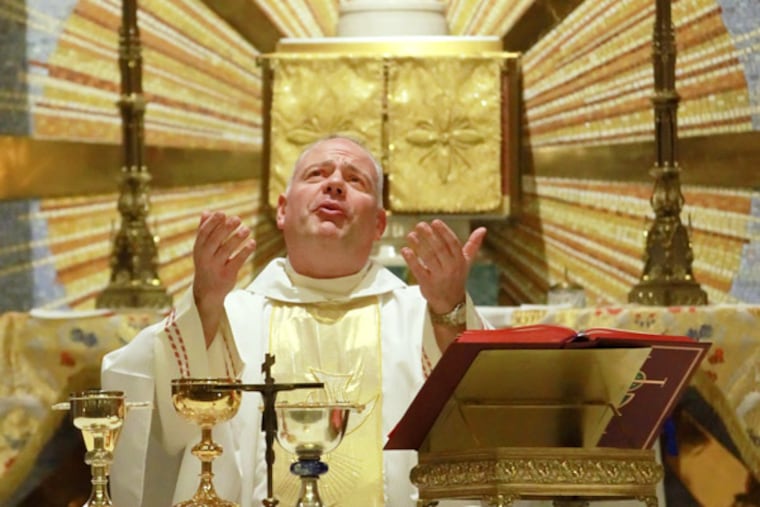West Oak Lane reunion to celebrate community
The entertainment at the first reunion, back when Beatlemania was peaking, consisted of a hi-fi and a stack of 45 r.p.m. records.

The entertainment at the first reunion, back when Beatlemania was peaking, consisted of a hi-fi and a stack of 45 r.p.m. records.
The draw for the next is strictly the people - their ranks halved by time and sickness.
The 1951 eighth-grade class of St. Athanasius Elementary School, a place then and now a West Oak Lane institution, held its 62d reunion at a Bucks County country club Sunday. It's a celebration of an educational milestone but also of a particular place and time.
If 62 seems an odd number for a reunion, that's because it's been, after all, 62 years. People are aging. What was an every-five-years get-together has been speeded up. Some three dozen people turned out Sunday.
"We had such a nice class, 120 kids - we knew them all," said Jane Smith Macklin, who has led the reunion organizing since the first in the mid-1960s. "We've kept together all these years."
The close collection of grade-schoolers split to attend different high schools - La Salle High, Northeast Catholic, Germantown, Olney, Little Flower, or Central High.
Their journey is in many ways a tale of two Philadelphias, of two neighborhoods, both of them called West Oak Lane and both in the same place geographically, but otherwise changed and different.
In the 1940s and 1950s, the neighborhood was defined by white, Irish Catholic, and Jewish families - the big baseball game was the Cedar Park club team vs. Temple Sinai. Today, West Oak Lane is a middle-class African American neighborhood, many of its residents working as teachers, police officers, and firefighters.
The neighborhood is home to about 36,000. Compared with the rest of the city, the residents tend to be a little older, and a little better off financially.
"The community, we're together," said Sara Willingham, who has lived in West Oak Lane about 28 years and teaches and worships at St. A's. "Everyone knows one another."
West Oak Lane stands in northwest Philadelphia, touching the suburbs on Cheltenham Avenue, its brick and stone rowhouses occasionally interrupted by single-family homes. On nice days, it seems as if everybody is outside clipping grass and sweeping front walks and porches.
"It's always been a stable, family-oriented community," said Father Joseph Okonski, who arrived as St. A's priest four years ago but knows the neighborhood well: He's one of a very few city priests who serve in the parish where they grew up.
Crime is an issue. On March 27, one man was killed and another wounded during a shooting on Ogontz Avenue. Two days later, a gunman fired through the door of a Chinese restaurant, wounding three young men. In April, a woman was stabbed to death during a dispute in her apartment.
Okonski believes drug traffic is behind much of the violence, and notes that a single dealer can create plenty of trouble.
His is an old parish, established in 1928 for a growing Catholic population. What is today called the "lower church," a large, fine chapel, opened in 1943, while the "upper church," as majestic as any to be found anywhere, opened in 1955.
Back then, the parish was so busy it held 10 Masses on Sundays. When the West Oak Lane branch of the Free Library opened in 1957, about 2,000 people poured through the doors in its first hour.
In the 1940s and 1950s, it seemed as if every kid played sports. In summer, it was baseball at Simons playground. In winter, shovels came out to clear snow from the basketball courts at Pennypacker School.
Everybody remembers the excitement when Ken Heintzelman, a Phillies pitcher, moved into a house near Pennypacker. In the evenings, kids would gather outside his home, and Heintzelman would sit on his front steps, sign autographs, and talk baseball.
"Fond memories, fond memories," said Robert J. "Bo" Terry, a retired Inquirer reporter. "It was a great place to live."
Donald's, a variety store on Washington Lane, was the place to stop for a Coke. A popular restaurant was the Shack, and on Valentine's Day, people bought candy at Hesch's Candies. The best corned beef sandwich? The Avenue Deli.
In the late 1960s and early 1970s, changing demographics and white flight altered the makeup of the neighborhood. The city was getting smaller, with people heading to the suburbs.
Temple Sinai moved to Dresher in 1979. Its old synagogue became the West Oak Lane Church of God. At St. A's, the shrinking Catholic population caused the closing of the regal upper church.
Under the leadership of Msgr. Herbert Bevard, now Bishop Bevard, the upper church was restored and reopened in the 1990s, as St. A's, like the neighborhood, sought its way forward.
The easiest way for people to get to St. A's on Sunday mornings is to follow their ears. The song of the choir wafts across Limekiln Pike.
At last Sunday's Mass, Okonski spoke of the need for people to bear witness, to inspire others with their own stories of how God has moved in them. The congregation prayed: for people killed in the factory collapse in Bangladesh, for an end to terrorism, for protection of the city's police and firefighters.
Many of the congregants arrived in the 1970s and laid down family roots. Many have attended for decades and wouldn't live or worship anywhere else.
"I like everything about it," said Theresa Allen, a West Oak Lane resident and church member since 1970. "Most of the people my children grew up with are back and living in the neighborhood. Your neighbors remain the same."